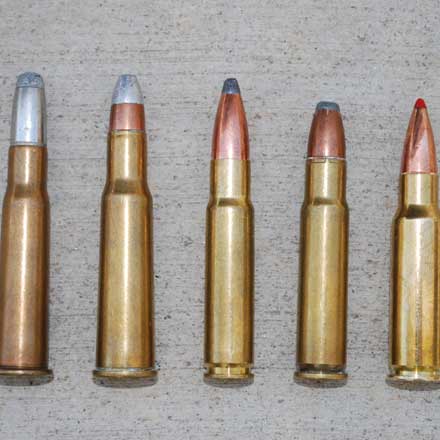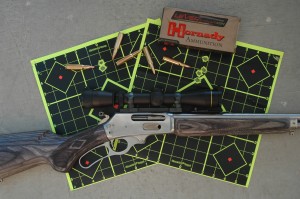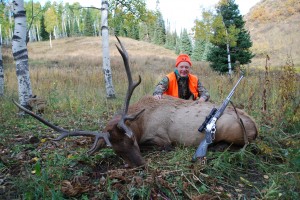
If we’re honest with ourselves, the good old .30-30 Winchester will handle most shots most of us make on deer—and it’s proven itself on elk and bear all too often to question its efficiency. But we American hunters crave velocity and power. We probably don’t need as much as we crave, but in open country, life is simpler with cartridges that shoot flatter, and for game larger than deer, more energy than Granddad’s .30-30 can deliver is useful.
Bolt actions have been delivering these things since before Roosevelt (Teddy, that is) was President. But true versatility in the all-American lever action has beenelusive. The 1895 Winchester, the same Roosevelt’s “lion medicine,” handles powerful cartridges, and its box magazine can use sharp-pointed aerodynamic bullets—but it’s a mess to put a scope on this action, so sighting equipment is a limitation. Other “box magazine” lever actions, like the Savage 99, Winchester Model 88, and Sako Finnwolf are readily scoped, but action length and width create other limitations. The .358 Winchester is a great step toward delivering large-caliber versatility in a lever gun. It remains one of my personal favorite cartridges, but the reality is the case capacity is just too small to deliver meaningful velocity with heavy bullets. The lone exception I am aware of is Browning’s long-action BLR-chambered in cartridges up to .338 Winchester Magnum—it’s a big action, andthus, a big rifle.
Of course, the classic form of the lever action is the tubular magazine, exposed hammer models from Marlin and Winchester. Historically, tubular magazinerifles have had their hands tied because of the necessity to use very blunt or flat-nosed bullets. Aerodynamics and downrange ballistics are terrible, but that beats risking detonation in the magazine. Efforts to upgrade their power and versatility of the tubular magazine rifle have included the .348 and .356 Winchester, both hampered by their blunt-nosed bullets. The .348 is another of my favorites. It has a big case with plenty of powder capacity, but the only rifle has ever been chambered to, the Model 71 Winchester (last iteration of John Browning’s great 1886 Winchester action) is another lever action that is almost impossible to put a scope on. The .356 is a semi-rimmed cartridge designed to duplicate .358 Winchester performance in a tubular magazine rifle, a good effort, but it suffers from the same problem the .358 has- lack of case...
capacity.
Hornady solved the bullet aerodynamics issue with their “LeveRevolution” ammo featuring their Flex-Tip bullet, a sharp pointed bullet with a “squishable” polymer tip,perfectly safe to use in tubular magazines. They added this bullet to the propellant technology of their Light and Heavy Magnum ammo lines to create the .308 Marlin Express, for the first time offering genuine .308 Winchester performance in a tubular magazine rifle.

Now we had truly versatile downrange ballistics in the easily scoped Marlin lever action, a genuine breakthrough in tubular magazine performance. Missing was a bit more caliber and bullet weight for those who wished to use a tubular magazine rifle for moose, bear, and general-purpose elk hunting. This is the niche filled by the .338 Marlin Express which was introduced in late 2008, and without question, the most versatile cartridge ever housed in a traditional tubular-magazine lever action.
Hornady’s initial intent, I think, was to simply neck up the .308 Marlin Express. Even with proprietary powders, there just wasn’t enough case capacity to get the velocity upto where they wanted it; the result would have been too similar to the .356 and .358 Winchester. Not wishing to reinvent the wheel, they took their slightly fatter .376 Steyr case, shortened it, necked it down, added a rim, and there you have it: The .338 Marlin Express.
Look, performance is not spectacular. This is not a belted or unbelted magnum; it’s designed for tubular-magazine actions, wherein both cartridge size and acceptable pressures are limitations. Within those limitations, it’s a whole new world of lever action performance. Hornady’s initial factory load features a very aerodynamic 200-grain FTX (Flex Tip Expanding) bullet at 2565 fps, delivering just shy of 3000 ft-lbs of muzzle energy. Although a bit slower than a .30-06 because of bullet aerodynamics, this loadessentially follows the ballistic curve of a standard 180-grain .30-06 with a spitzer bullet, which ain’t all bad for a tubular magazine lever gun! Sight in three inches high at 100 yards, you’re 1.3 inches low at 200 yards, and with a bit less than eight inches of drop at 300...
yards, you’re still “minute of elk” with a center-chest hold.

I grabbed hold of one of the first Marlin rifles and took it elk hunting. Because of luck and timing, I dropped the first elk to fall to the .338 Marlin Express. Performance wasimpressively perfect with a 200-yard shot, but far more impressive were the groups delivered by this rifle, itself a prototype, with first-run Hornady ammo. One-inch groupsat 100 yards were not a problem, and I got enough that were well under a half-inch to accept that these were not flukes, although I certainly couldn’t do that every time. This is amazing performance from a factory rifle with factory ammo. But, a traditionaltubular magazine lever gun? Awesome!
The .338 Marlin Express shoots flat enough and accurately enough for almost any deer hunting, but if you don’t hunt game larger than deer, you don’t need it. On the otherhand, if you’re looking for a lever action with maximum versatility, I truly believe it’s the “best lever ever.” I drew a Shiras moose tag in Colorado this fall, and that’s the next time I’ll use the .338 ME. I’m not worried about it handling any shot I might need to take!